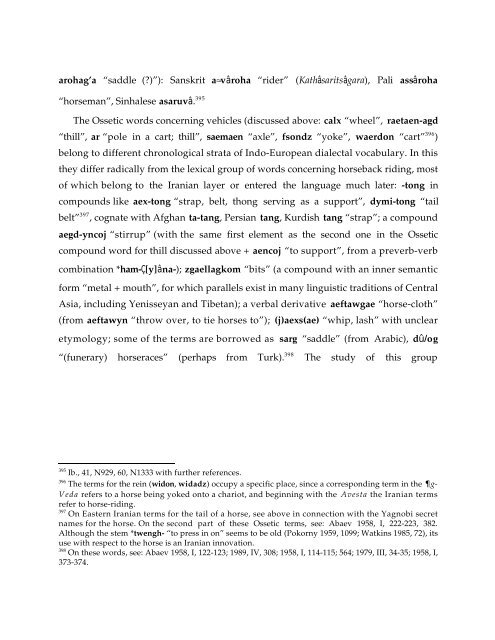Comparative Notes on Hurro-Urartian, Northern Caucasian
Comparative Notes on Hurro-Urartian, Northern Caucasian
Comparative Notes on Hurro-Urartian, Northern Caucasian
You also want an ePaper? Increase the reach of your titles
YUMPU automatically turns print PDFs into web optimized ePapers that Google loves.
arohag’a “saddle (?)”): Sanskrit a≈vâroha “rider” (Kathâsaritsâgara), Pali assâroha<br />
“horseman”, Sinhalese asaruvâ. 395<br />
The Ossetic words c<strong>on</strong>cerning vehicles (discussed above: calx “wheel”, raetaen-a d<br />
“thill”, ar “pole in a cart; thill”, saemaen “axle”, fs<strong>on</strong>dz “yoke”, waerd<strong>on</strong> “cart” 396 )<br />
bel<strong>on</strong>g to different chr<strong>on</strong>ological strata of Indo-European dialectal vocabulary. In this<br />
they differ radically from the lexical group of words c<strong>on</strong>cerning horseback riding, most<br />
of which bel<strong>on</strong>g to the Iranian layer or entered the language much later: -t<strong>on</strong>g in<br />
compounds like aex-t<strong>on</strong>g “strap, belt, th<strong>on</strong>g serving as a support”, dymi-t<strong>on</strong>g “tail<br />
belt” 397 , cognate with Afghan ta-tang, Persian tang, Kurdish tang “strap”; a compound<br />
ae d-yncoj “stirrup” (with the same first element as the sec<strong>on</strong>d <strong>on</strong>e in the Ossetic<br />
compound word for thill discussed above + aencoj “to support”, from a preverb-verb<br />
combinati<strong>on</strong> *ham-Ç[y]âna-); z aellagkom “bits” (a compound with an inner semantic<br />
form “metal + mouth”, for which parallels exist in many linguistic traditi<strong>on</strong>s of Central<br />
Asia, including Yenisseyan and Tibetan); a verbal derivative aeftawgae “horse-cloth”<br />
(from aeftawyn “throw over, to tie horses to”); (j)aexs(ae) “whip, lash” with unclear<br />
etymology; some of the terms are borrowed as sar “saddle” (from Arabic), dû/o<br />
“(funerary) horseraces” (perhaps from Turk). 398 The study of this group<br />
395 Ib., 41, N929, 60, N1333 with further references.<br />
396 The terms for the rein (wid<strong>on</strong>, widadz) occupy a specific place, since a corresp<strong>on</strong>ding term in the g-<br />
Veda refers to a horse being yoked <strong>on</strong>to a chariot, and beginning with the Avesta the Iranian terms<br />
refer to horse-riding.<br />
397 On Eastern Iranian terms for the tail of a horse, see above in c<strong>on</strong>necti<strong>on</strong> with the Yagnobi secret<br />
names for the horse. On the sec<strong>on</strong>d part of these Ossetic terms, see: Abaev 1958, I, 222-223, 382.<br />
Although the stem *twengh- “to press in <strong>on</strong>” seems to be old (Pokorny 1959, 1099; Watkins 1985, 72), its<br />
use with respect to the horse is an Iranian innovati<strong>on</strong>.<br />
398 On these words, see: Abaev 1958, I, 122-123; 1989, IV, 308; 1958, I, 114-115; 564; 1979, III, 34-35; 1958, I,<br />
373-374.





